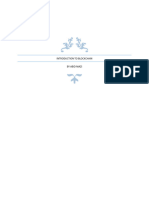Class Note 1: Blockchain Technology and Its Applications
What is Blockchain?
Blockchain is a decentralized, distributed ledger technology that records
transactions across multiple computers securely and transparently. Each record, or
"block," contains a timestamp, transaction data, and a unique cryptographic hash
that links it to the previous block, forming a chain.
Key Features:
Decentralization: No central authority controls the data; instead, it’s distributed
across a network.
Immutability: Once a block is added, its data cannot be altered without consensus
from the network.
Transparency: All transactions are visible to participants in the network.
Security: Cryptographic algorithms ensure data integrity and protect against
unauthorized access.
How Blockchain Works:
A transaction is initiated (e.g., sending cryptocurrency).
The transaction is verified by network nodes through consensus mechanisms like
Proof of Work (PoW) or Proof of Stake (PoS).
The verified transaction is bundled into a block.
The block is added to the chain, and the ledger is updated across all nodes.
Applications:
Cryptocurrency: Bitcoin and Ethereum are the most notable examples, enabling peer-
to-peer transactions without intermediaries.
Smart Contracts: Self-executing contracts where terms are coded directly into the
blockchain (e.g., Ethereum).
Supply Chain Management: Enhances transparency and traceability, ensuring the
authenticity of goods.
Healthcare: Secures patient records and enables interoperability between healthcare
providers.
Voting Systems: Provides tamper-proof election processes, ensuring transparency and
fairness.
Challenges:
Scalability: Blockchain networks can become slow as they grow.
Energy Consumption: Mining in PoW systems consumes significant energy.
Regulation: Governments are still working on frameworks to regulate blockchain use.
Blockchain is transforming industries by fostering trust, transparency, and
efficiency. As technology evolves, it is expected to play a critical role in
shaping the future digital landscape.























































